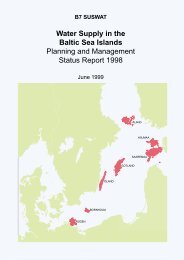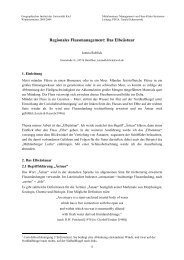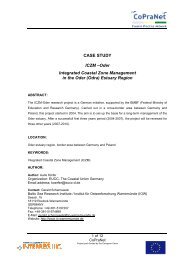View - IKZM-D Lernen
View - IKZM-D Lernen
View - IKZM-D Lernen
You also want an ePaper? Increase the reach of your titles
YUMPU automatically turns print PDFs into web optimized ePapers that Google loves.
Haas & Peekna & Walker Folklore 23<br />
As the sun goes down in the west and rises in the east, it looks like<br />
it spends the night underground, hence the image of a stone cellar<br />
would be appropriate, apart from the meteorite crash. This is the<br />
kind of interpretation we find in the artwork of the Finno-Ugrians<br />
of the Perm district of Russia, where carved boards at the top and<br />
bottom of windows, respectively, show images of the sun on its daytime<br />
journey across the sky and on its nocturnal return trip through<br />
the underworld, symbolized by a lizard’s claws (Põllu 1985: 52–53).<br />
From a vantage point on the Estonian mainland, the meteorite would<br />
have had the appearance of a streak in the sky. This might explain<br />
why we can more easily find Estonian tales of flying, fiery serpents<br />
and the like (see below). It is noteworthy that a shooting star is<br />
called pisuhänd ‘spark-tail’ in Eastern Estonia, but tulihänd ‘firetail’<br />
in Western Estonia, perhaps reflecting the relative harmlessness<br />
versus destructive reality of the meteorite from those respective<br />
vantage points (Tiirmaa 1994: 66, citing Andrus Saareste’s article<br />
in Eesti Keele Arhiivi Toimetised 1).<br />
From the vantage point of Sweden, on the other hand, the tail of<br />
the meteorite would have been less prominent and it would have<br />
been more natural to think of the event as a falling fireball. This<br />
may explain why Scandinavian mythology shows more concern about<br />
the sun being brought down to earth. It is noteworthy that the<br />
prophecy of the end of the gods involves the monstrous Fenrir-wolf,<br />
in a distant “iron forest” to the east, who swallows the sun, causes<br />
earthquakes powerful enough to split and crumble mountains, and<br />
causes the gods to perish in fire and battle (Larousse Encyclopedia<br />
of Mythology 1959: 283; Meri 1984: 92-3). 1 What’s more, the prophesied<br />
end of the world includes a battle between the thunder god<br />
Thor and the great earthquake-causing serpent of Midgard, which<br />
leads people to flee their homes, turns the sun black, brings hot<br />
stars down from the heavens, burns the land, poisons the air, and<br />
causes the earth to sink into the sea (Bellows 1969 [1923]). As the<br />
shoreline was quite close to the Kaali crater at the time of the<br />
disaster (Tiirmaa 1994: 21–23), the appearance of a lake in the bottom<br />
of the pit could certainly look like a sinking of the land. In<br />
these myths, there is not just a vague reference about the sun’s<br />
being hidden or hampered by stones, but a whole series of details<br />
that fit the meteorite crash quite well.<br />
www.folklore.ee/folklore/vol23<br />
60

















